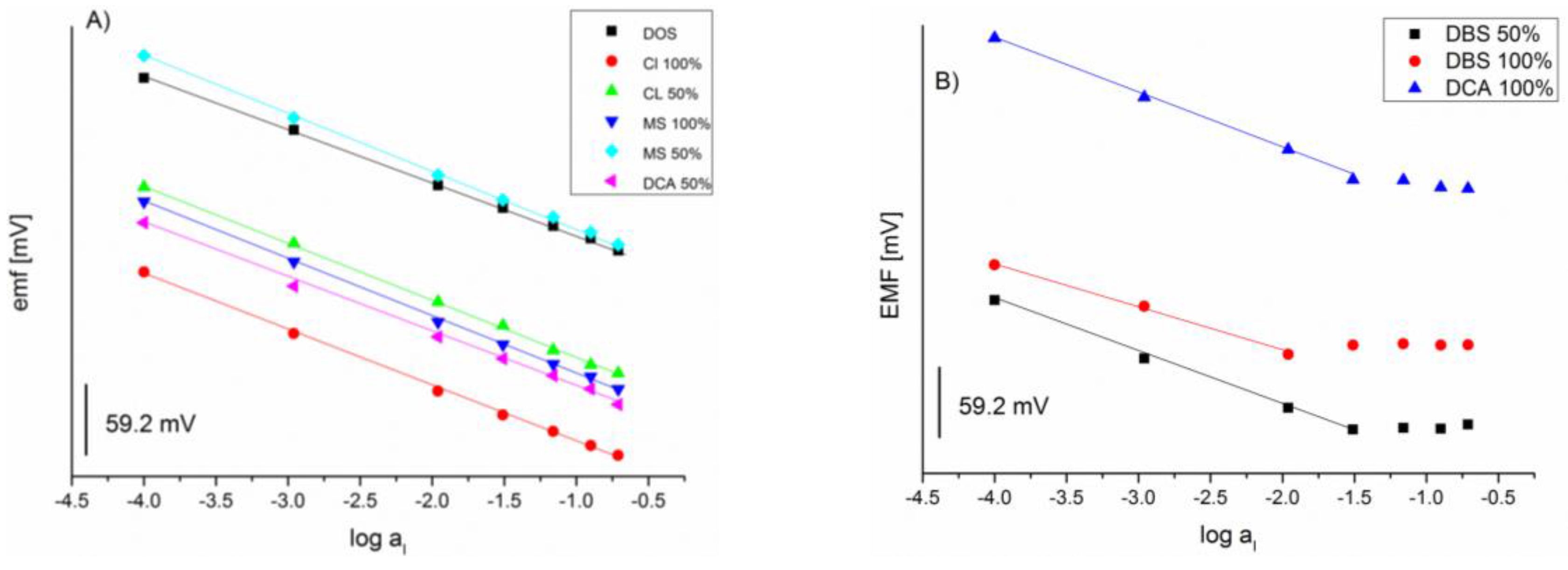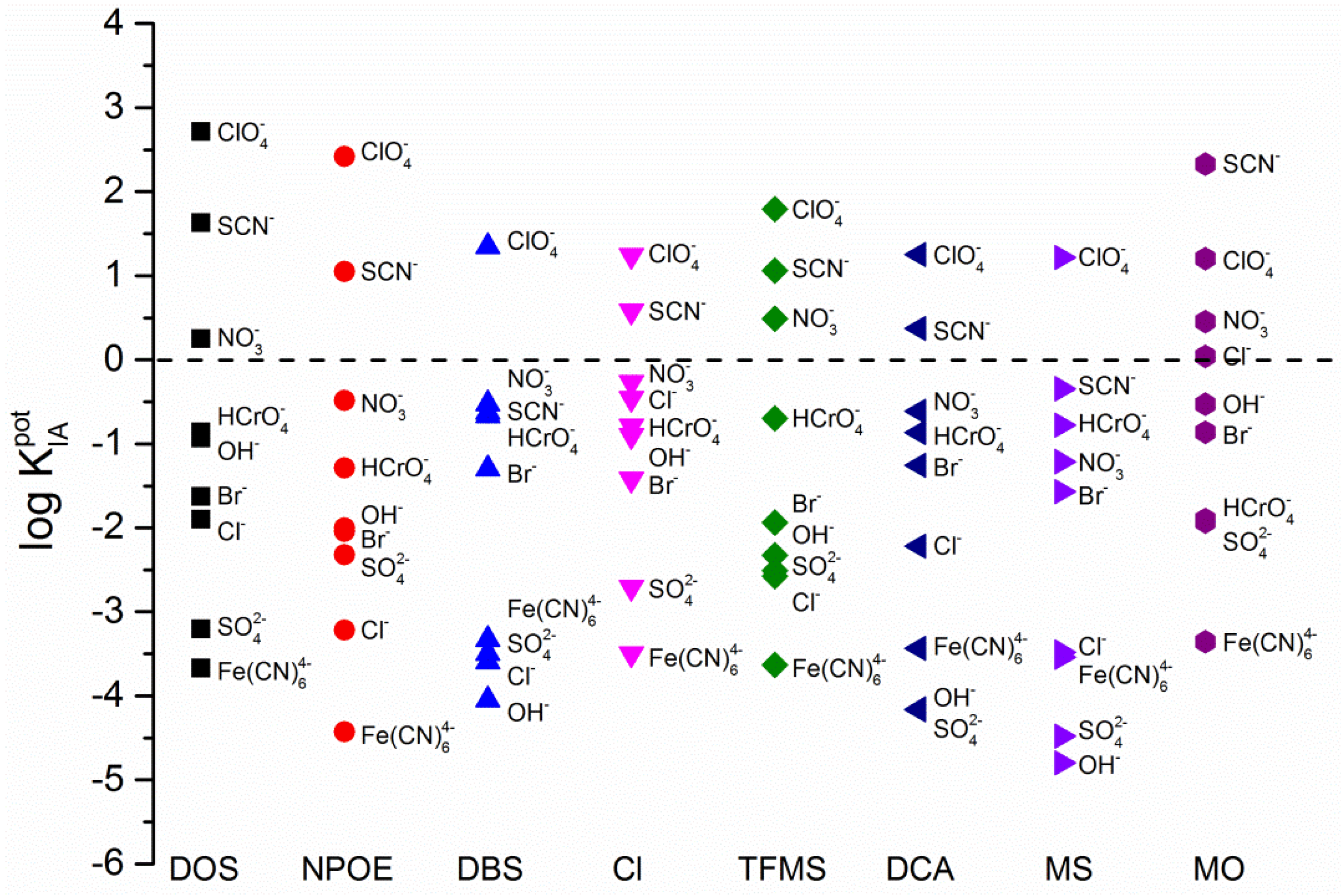Influence of Ionic Liquids on the Selectivity of Ion Exchange-Based Polymer Membrane Sensing Layers
Abstract
:1. Introduction
2. Experimental Section
2.1. Materials
2.2. Preparation of Ionophore-Free Sensing Membranes
2.3. EMF Measurements
2.4. Electrochemical Impedance Spectroscopy
2.5. Selectivity Measurements
3. Results and Discussion
3.1. Role of Ionic Liquids
3.2. Selectivity Measurements
4. Conclusions
Supplementary Materials
Acknowledgments
Author Contributions
Conflicts of Interest
References
- Coll, C.; Labrador, R.H.; Mañez, R.M.; Soto, J.; Sancenón, F.; Seguí, M.-J.; Sanchez, E. Ionic liquids promote selective responses towards the highly hydrophilic anion sulfate in PVC membrane ion-selective electrodes. Chem. Commun. 2005, 3033–3035. [Google Scholar] [CrossRef] [PubMed]
- Hofmeister, F. Zur lehre von der wirkung der salze. Arch. Exp. Pathol. Pharmakol. 1888, 25, 1–30. (In German) [Google Scholar] [CrossRef]
- Chatterjee, S.; Bryan, S.A.; Seliskar, C.J.; Heineman, W.R. Three-component spectroelectrochemical sensor module for the detection of pertechnetate (TcO4−). Rev. Anal. Chem. 2013, 32, 209–224. [Google Scholar] [CrossRef]
- Schroll, C.A.; Chatterjee, S.; Heineman, W.R.; Bryan, S.A. Semi-infinite linear diffusion spectroelectrochemistry on an aqueous micro-drop. Anal. Chem. 2011, 83, 4214–4219. [Google Scholar] [CrossRef] [PubMed]
- Morris, L.K.; Seliskar, C.J.; Bryan, S.A.; Heineman, W.R.; Burgess, D.; Owen, G.; Rana, H.; Zamboni, R.; Kajzar, F.; Szep, A.A. (Eds.) Chemical Sensing with Solid State Devices; Academic Press: Boston, MA, USA, 2014; p. 925311.
- Wan, H.; Ha, D.; Zhang, W.; Zhao, H.; Wang, X.; Sun, Q.; Wang, P. Design of a novel hybrid sensor with microelectrode array and LAPS for heavy metal determination using multivariate nonlinear calibration. Sens. Actuators B Chem. 2014, 192, 755–761. [Google Scholar] [CrossRef]
- Bakker, E.; Bühlmann, P.; Pretsch, E. Polymer membrane ion-selective electrodes—What are the limits? Electroanalysis 1999, 11, 915–933. [Google Scholar] [CrossRef]
- Shioya, T.; Nishizawa, S.; Teramae, N. Anion recognition at the liquid-liquid interface. Sulfate transfer across the 1,2-dichloroethane-water interface facilitated by hydrogen-bonding ionophores. J. Am. Chem. Soc. 1998, 120, 11534–11535. [Google Scholar] [CrossRef]
- Bakker, E.; Bühlmann, P.; Pretsch, E. Carrier-based ion-selective electrodes and bulk optodes. 1. General characteristics. Chem. Rev. 1997, 97, 3083–3132. [Google Scholar] [CrossRef] [PubMed]
- Koryta, J. Theory and applications of ion-selective electrodes. Anal. Chim. Acta 1972, 61, 329–411. [Google Scholar] [CrossRef]
- Ho, T.D.; Zhang, C.; Hantao, L.W.; Anderson, J.L. Ionic liquids in analytical chemistry: Fundamentals, advances, and perspectives. Anal. Chem. 2014, 86, 262–285. [Google Scholar] [CrossRef] [PubMed]
- Ahrens, S.; Peritz, A.; Strassner, T. Tunable aryl alkyl ionic liquids (TAAILs): The next generation of ionic liquids. Angew. Chem. Int. Ed. 2009, 48, 7908–7910. [Google Scholar] [CrossRef] [PubMed]
- Dias, A.M.A.; Marceneiro, S.; Braga, M.E.M.; Coelho, J.F.J.; Ferreira, A.G.M.; Simões, P.N.; Veiga, H.I.M.; Tomé, L.C.; Marrucho, I.M.; Esperança, J.M.S.S.; et al. Phosphonium-based ionic liquids as modifiers for biomedical grade poly (vinyl chloride). Acta Biomater. 2012, 8, 1366–1379. [Google Scholar] [CrossRef] [PubMed]
- Wanigasekara, E.; Perera, S.; Crank, J.A.; Sidisky, L.; Shirey, R.; Berthod, A.; Armstrong, D.W. Bonded ionic liquid polymeric material for solid-phase microextraction GC analysis. Anal. Bioanal. Chem. 2010, 396, 511–524. [Google Scholar] [CrossRef] [PubMed]
- Wang, Y.; Tian, M.; Bi, W.; Row, K.H. Application of ionic liquids in high performance reversed-phase chromatography. Int. J. Mol. Sci. 2009, 10, 2591–2610. [Google Scholar] [CrossRef] [PubMed]
- Peng, B.; Zhu, J.; Liu, X.; Qin, Y. Potentiometric response of ion-selective membranes with ionic liquids as ion-exchanger and plasticizer. Sens. Actuators B Chem. 2008, 133, 308–314. [Google Scholar] [CrossRef]
- Zhuo, K.; Wei, Y.; Ma, J.; Chen, Y.; Bai, G. Response of PVC membrane ion-selective electrodes to alkylmethylimidazolium ionic liquid cations. Sens. Actuators B Chem. 2013, 186, 461–465. [Google Scholar] [CrossRef]
- Wardak, C. Solid Contact Nitrate Ion-Selective Electrode Based on Ionic Liquid with Stable and Reproducible Potential. Electroanalysis 2014, 26, 864–872. [Google Scholar] [CrossRef]
- Mendecki, L.; Chen, X.; Callan, N.; Thompson, D.; Schazmann, B.; Granados-Focil, S.; Radu, A. Simple, Robust, and Plasticizer-Free Iodide-Selective Sensor Based on Copolymerized Triazole-Based Ionic Liquid. Anal. Chem. 2016, 88, 4311–4317. [Google Scholar] [CrossRef] [PubMed]
- Kakiuchi, T. Electrochemical aspects of ionic-liquid| water two-phase systems. Anal. Chem. 2007, 79, 6442–6449. [Google Scholar] [CrossRef]
- Kakiuchi, T.; Yoshimatsu, T. A new salt bridge based on the hydrophobic room-temperature molten salt. Bull. Chem. Soc. Jpn. 2006, 79, 1017–1024. [Google Scholar] [CrossRef]
- Kakiuchi, T.; Tsujioka, N.; Kurita, S.; Iwami, Y. Phase-boundary potential across the nonpolarized interface between the room-temperature molten salt and water. Electrochem. Commun. 2003, 5, 159–164. [Google Scholar] [CrossRef]
- Fraser, K.J.; MacFarlane, D.R. Phosphonium-based ionic liquids: An overview. Aust. J. Chem. 2009, 62, 309–321. [Google Scholar] [CrossRef]
- Rahman, M.; Brazel, C.S. Ionic liquids: New generation stable plasticizers for poly (vinyl chloride). Polym. Degrad. Stab. 2006, 91, 3371–3382. [Google Scholar] [CrossRef]
- Weingärtner, H. The static dielectric permittivity of ionic liquids. J. Mol. Liq. 2014, 192, 185–190. [Google Scholar] [CrossRef]
- Prete, A.; Paragliola, R.M.; Corsello, S.M. Iodine Supplementation: Usage “with a Grain of Salt”. Int. J. Endocrinol. 2015, 2015, 312305. [Google Scholar] [CrossRef] [PubMed]
- Radu, A.; Anastasova-Ivanova, S.; Paczosa-Bator, B.; Danielewski, M.; Bobacka, J.; Lewenstam, A.; Diamond, D. Diagnostic of functionality of polymer membrane–based ion selective electrodes by impedance spectroscopy. Anal. Methods 2010, 2, 1490–1498. [Google Scholar] [CrossRef] [Green Version]
- O’Rourke, M.; Duffy, N.; Marco, R.D.; Potter, I. Electrochemical impedance spectroscopy—A simple method for the characterization of polymer inclusion membranes containing Aliquat 336. Membranes 2011, 1, 132–148. [Google Scholar] [CrossRef] [PubMed]
- Brinkman, U.A.T.; Bruno, A.E.; Burlingame, A.L. TRAC: Trends in Analytical Chemistry, 1st ed.; Elsevier Science: New York, NY, USA, 2013; Volume 10. [Google Scholar]
- Qin, Y.; Bakker, E. Evaluation of the separate equilibrium processes that dictate the upper detection limit of neutral ionophore-based potentiometric sensors. Anal. Chem. 2002, 74, 3134–3141. [Google Scholar] [CrossRef] [PubMed]
- Malon, A.; Radu, A.; Qin, W.; Qin, Y.; Ceresa, A.; Maj-Zurawska, M.; Bakker, E.; Pretsch, E. Improving the detection limit of anion-selective electrodes: An iodide-selective membrane with a nanomolar detection limit. Anal. Chem. 2003, 75, 3865–3871. [Google Scholar] [CrossRef] [PubMed]
- Cheng, D.C.; Gulari, E. Micellization and intermicellar interactions in aqueous sodium dodecyl benzene sulfonate solutions. J. Colloid Interface Sci. 1982, 90, 410–423. [Google Scholar] [CrossRef]
- Schaller, U.; Bakker, E.; Spichiger, U.E.; Pretsch, E. Ionic additives for ion-selective electrodes based on electrically charged carriers. Anal. Chem. 1994, 66, 391–398. [Google Scholar] [CrossRef]
- Grygolowicz-Pawlak, E.; Crespo, G.A.; Ghahraman Afshar, M.; Mistlberger, G.; Bakker, E. Potentiometric sensors with ion-exchange donnan exclusion membranes. Anal. Chem. 2013, 85, 6208–6212. [Google Scholar] [CrossRef] [PubMed]
- Pérez, M.D.L.A.A.; Marı́n, L.P.; Quintana, J.C.; Yazdani-Pedram, M. Influence of different plasticizers on the response of chemical sensors based on polymeric membranes for nitrate ion determination. Sens. Actuators B Chem. 2003, 89, 262–268. [Google Scholar] [CrossRef]



| PVC Membrane Composition | Dielectric Constant |
|---|---|
| 33% PVC, 66% DOS | 13 ± 1 |
| 33% PVC, 66% NPOE | 23.6 ± 0.5 |
| 33% PVC, 66% DBS− | 40.0 ± 0.4 |
| 33% PVC, 66% DCA−, Cl−, TFMS−, MS−, MO− | N/A |
| PVC Membrane Composition | Dielectric Constant |
|---|---|
| 33% PVC, 66% DBS− | 40 ± 2 |
| 33% PVC, 50% DOS and 50% DBS− | 312 ± 8 |
| 33% PVC, 66% DOS and 33% DBS− | 48 ± 1 |
| Anion/Type | DOS | NPOE | [DBS−] | [Cl−] | [TFMS−] | [DCA−] | [MS−] | [MO−] |
|---|---|---|---|---|---|---|---|---|
| ClO4− | 2.71 ± 0.04 | 2.42 ± 0.11 | 1.35 ± 0.26 | 1.24 ± 0.05 | 1.79 ± 0.03 | 1.25 ± 0.02 | 1.22 ± 0.06 | 1.20 ± 0.11 |
| SCN− | 1.63 ± 0.10 | 1.05 ± 0.10 | −0.52 ± 0.05 | 0.58 ± 0.09 | 1.06 ± 0.13 | 0.37 ± 0.09 | −0.35 ± 0.06 | 2.33 ± 0.04 |
| NO3− | 0.25 ± 0.03 | −0.49 ± 0.00 | −0.62 ± 0.08 | −0.27 ± 0.08 | 0.49 ± 0.03 | −0.61 ± 0.09 | −1.21 ± 0.07 | 0.45 ± 0.03 |
| HCrO4− | −0.86 ± 0.16 | −1.29 ± 0.13 | −0.67 ± 0.06 | −0.79 ± 0.07 | −0.70 ± 0.05 | −0.87 ± 0.01 | −0.78 ± 0.15 | −1.90 ± 0.06 |
| OH− | −0.93 ± 0.04 | −2.00 ± 0.06 | −4.05 ± 0.13 | −0.90 ± 0.11 | −2.33 ± 0.02 | −4.16 ± 0.09 | −4.80 ± 0.09 | −0.53 ± 013 |
| Br− | −1.63 ± 0.02 | −2.05 ± 0.01 | −1.30 ± 0.03 | −1.42 ± 0.07 | −1.94 ± 0.12 | −1.26 ± 0.04 | −1.57 ± 0.04 | −0.86 ± 0.01 |
| Cl− | −1.90 ± 0.08 | −3.22 ± 0.02 | −3.59 ± 0.01 | −0.46 ± 0.01 | −2.58 ± 0.01 | −2.22 ± 0.13 | −3.48 ± 0.01 | 0.04 ± 0.01 |
| Fe(CN)64− | −3.67 ± 0.06 | −4.43 ± 0.01 | −3.33 ± 0.06 | −3.50 ± 0.13 | −3.63 ± 0.05 | −3.44 ± 0.11 | −3.54 ± 0.06 | −3.36 ± 0.10 |
| SO42− | −3.21 ± 0.01 | −2.33 ± 0.00 | −3.49 ± 0.12 | −2.71 ± 0.01 | −2.51 ± 0.03 | −4.17 ± 0.01 | −4.48 ± 0.01 | −1.93 ± 0.02 |
© 2016 by the authors; licensee MDPI, Basel, Switzerland. This article is an open access article distributed under the terms and conditions of the Creative Commons Attribution (CC-BY) license (http://creativecommons.org/licenses/by/4.0/).
Share and Cite
Mendecki, L.; Callan, N.; Ahern, M.; Schazmann, B.; Radu, A. Influence of Ionic Liquids on the Selectivity of Ion Exchange-Based Polymer Membrane Sensing Layers. Sensors 2016, 16, 1106. https://doi.org/10.3390/s16071106
Mendecki L, Callan N, Ahern M, Schazmann B, Radu A. Influence of Ionic Liquids on the Selectivity of Ion Exchange-Based Polymer Membrane Sensing Layers. Sensors. 2016; 16(7):1106. https://doi.org/10.3390/s16071106
Chicago/Turabian StyleMendecki, Lukasz, Nicole Callan, Meghan Ahern, Benjamin Schazmann, and Aleksandar Radu. 2016. "Influence of Ionic Liquids on the Selectivity of Ion Exchange-Based Polymer Membrane Sensing Layers" Sensors 16, no. 7: 1106. https://doi.org/10.3390/s16071106






